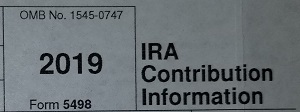So we’ve talked about how to calculate your Required Minimum Distributions (RMD) from your IRA and when you must take it. But how does the IRS know that you’ve done what you’re supposed to? How does RMD reporting work? As you might expect, the IRS doesn’t leave it to chance. They know exactly what you’ve done or not done.

Photo credit: jb
When you receive a distribution from an IRA, a Form 1099-R is generated at the end of the tax year. If the distribution is for your RMD for the year (treated as a normal distribution) there will be a Code of 7 in Box 7 of the form. This will be true of any amount that you receive from your IRA in a “normal” distribution. The amount of the distribution will be found in Box 1 of the form, and the taxable amount will be in Box 2.

Photo credit: jb
In addition, Form 5498 will be generated for your IRA and sent to you by January 31 of the following year – meaning, if you receive a 5498 before January 31 of the current year, it is relating to an IRA balance as of December 31 of the prior year. This statement will detail the amount of your RMD if you’re over age 70½ (or over 72 beginning in 2021).
Both of these forms are filed with the IRS at the same time that they’re sent to you. So the IRS simply cross-references the distribution (Form 1099-R) with the balance information from Form 5498, thereby making sure that you have taken the appropriate distribution. It’s not always as simple as that, since the IRS must aggregate all of your IRA balances together, as well as all of your distributions, before making the calculations.
If you haven’t taken the distribution as you should have, you’ll receive a communication (often a year or two later) from the IRS asking what’s up (in so many words). The unfortunate problem is that you’ll be subjected to a 50% penalty for not taking the RMD in a timely manner – quite an exorbitant amount, you’ll agree.
Do I have an RMD reporting requirement?
So when you take the distribution, is there a check-box or something for RMD reporting? Maybe something that says the distribution is an RMD? The answer is no. When you’re subject to RMDs, the first money that you take out of your IRAs is counted toward satisfying your RMD for the year. As long as you take that required amount out, whether from one IRA or all of your IRAs together, the RMD is satisfied.
For employer plans, including 401(k), 457, and SEP/SIMPLE plans, you must take the RMD from each account separately, they’re not aggregated like IRAs are, nor are they lumped together with IRAs. 403(b) plans may be aggregated like IRAs can be, but not aggregated with IRAs. Just keep this in mind as you plan your distributions for the year.


 Sterling Raskie, MSFS, CFP®, ChFC®
Sterling Raskie, MSFS, CFP®, ChFC® The latest in our Owner’s Manual series, A 401(k) Owner’s Manual, was published in January 2020 and is available on
The latest in our Owner’s Manual series, A 401(k) Owner’s Manual, was published in January 2020 and is available on  A Medicare Owner’s Manual, is updated with 2020 facts and figures. This manual is available on
A Medicare Owner’s Manual, is updated with 2020 facts and figures. This manual is available on  Social Security for the Suddenly Single can be found on Amazon at
Social Security for the Suddenly Single can be found on Amazon at  Sterling’s first book, Lose Weight Save Money, can be
Sterling’s first book, Lose Weight Save Money, can be  An IRA Owner’s Manual, 2nd Edition is available for purchase on Amazon. Click the link to choose the
An IRA Owner’s Manual, 2nd Edition is available for purchase on Amazon. Click the link to choose the  Jim’s book – A Social Security Owner’s Manual, is now available on Amazon. Click this link for the
Jim’s book – A Social Security Owner’s Manual, is now available on Amazon. Click this link for the  And if you’ve come here to learn about queuing waterfowl, I apologize for the confusion. You may want to discuss your question with Lester, my loyal watchduck and self-proclaimed “advisor’s advisor”.
And if you’ve come here to learn about queuing waterfowl, I apologize for the confusion. You may want to discuss your question with Lester, my loyal watchduck and self-proclaimed “advisor’s advisor”.
Do I need to file taxes to report my RMD if I am otherwise exempt from filing federal taxes because I do not meet the income requirements?
You need to determine whether the RMD changes your tax filing situation. Depending on the amount of the RMD, it could bring you up to a point where you are liable for tax. Most online tax filing services can determine this for you, and if you don’t need to file there won’t be any cost.
Took my rmd’s in January and found out I can return the money back into my funds. Since I got a 1099 for the first amt, which forms indicate that I returned the money.
If you made a deposit into an IRA you should receive a Form 5498 from the custodian indicating that fact. Your statements from the custodian should also indicate the deposit. Your tax preparer can use either as evidence that the withdrawal was ultimately returned to the account (or another valid recipient account).
I thought that I may aggregate the RMDs from all my 403(b) accounts and take them from any combination of accounts, including the case of taking them all from one account.
You’re right! My apologies for the confusion. 403(b) plans are the one type of plan besides an IRA that can be aggregated and a single RMD taken from as little as one account. I’ve updated the article to reflect that fact.
Thanks for reaching out with this!